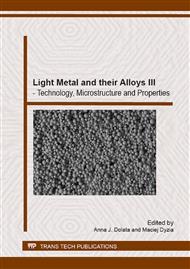p.3
p.9
p.15
p.23
p.31
p.39
p.47
p.53
Effect of Ti Addition to Zn Filler Metal on Wettability and Reinforcement of Soldered Joint of Aluminum
Abstract:
This article presents the phisicochemical propreties of aluminium brings a lot of difficulties during soldering one of tchem is low melting point. The work also presents results of mechanical and metallographic investigations. Structural examination was performed by means of light microscopy and mechanical properties with the aim of shear strength test. On the basis structural investigation joints made with Zn and Zn with Ti addition indicated possibilities of reinforcement of soldered joint of aluminium
Info:
Periodical:
Pages:
23-30
Citation:
Online since:
November 2013
Authors:
Price:
Сopyright:
© 2014 Trans Tech Publications Ltd. All Rights Reserved
Share:
Citation:


